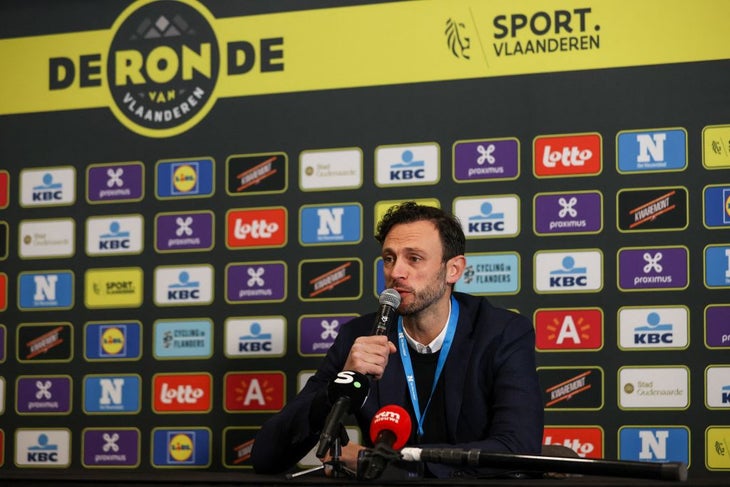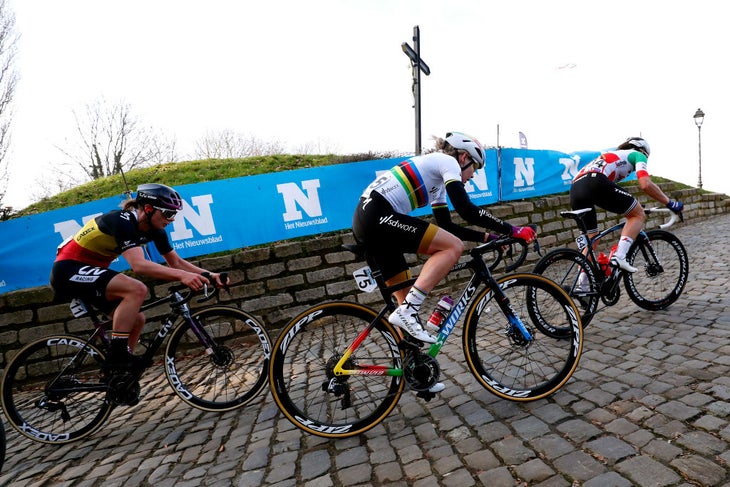Heading out the door? Read this article on the new Outside+ app available now on iOS devices for members! Download the app.
Women’s road racing is as strong as it’s ever been.
The number of high-quality events has grown dramatically over the past few years, as has the quantity of bigger budget teams paying riders sizeable salaries. With that, the strength and depth of the peloton has exploded, making the racing even more exciting.
Yet parity with men’s racing remains ever so far away.
Salaries and team budgets are still tiny compared to their male counterparts, and women’s races can often feel like they’re an afterthought rather than a major event. Some progress has been made, and it has had a huge impact, but much more still needs to be done.
Flanders Classics – the organizers of such races as the Tour of Flanders and Gent-Wevelgem – has been one of the big forces in helping to push women’s cycling to new heights.
“If you see where women’s cycling is coming from and the way it has evolved in the past years, it’s amazing and it’s great,” Flanders Classics CEO Tomas Van Den Spiegel told VeloNews.
Also read: The Outer Line: Race economics — what COVID-19 has revealed
“We are really building something here. We’re creating interest in women’s cycling and I think that’s the main goal, to gain fans and have better TV coverage, and for people to realize that it is as good as the men’s races.”
Viewing figures have shown a growing interest in women’s racing, with Marianne Vos’s Amstel Gold victory watched by more people in the Netherlands than Wout Van Aert’s win at the same race. The cold, hard figures have put paid to the notion that people aren’t interested in it.
An increasing number of races are now rewarding hardcore fans with live pictures. A successful crowdfunding campaign by the Healthy Ageing Tour to secure television coverage of it showed that viewers are willing to put their money where their mouth is.
Once again in the Netherlands a women's cycling race was better watched than the men's version: 480K & 37% share #AGRWomen vs. 400K & 15% #AGRmen Reach for men's race was much higher though: 1,867K v 877K (Note women's race was only 1h, men's race was 3h.) #gender #equity #sport
— Daam Van Reeth (@vrdaam) April 19, 2021
A long way to go for parity

It can be easy to get carried away with the progress that has been made over the last decade, but there is still a very long way to go before there is anything that can be considered parity with the men’s side of the sport.
The women’s calendar is still comparatively small, as are the number of races available to watch on television. While the average salary in the WorldTour peloton has grown by 25 percent — according to a study commissioned by the UCI — The Cyclists’ Alliance reported that wage disparity between those at the top and the bottom of the sport was growing in 2020.
Also read: Flanders Classics CEO: ‘The prize money was according to the UCI financial obligations’
A survey by The Cyclists’ Alliance showed that the number of female professional riders receiving no salary at all had grown from 17 to 25 percent between 2019 and 2020. Meanwhile, women’s prize money continues to be a hot topic.
Flanders Classics was at the receiving end of some criticism for the disparity between its prize money at Omloop Het Niewsblad. Women’s winner Anna van der Breggen received just €930 ($1,100) while men’s victor Davide Ballerini took home a tidy €16,000 ($19,500).
I do absolutely understand the concerns about equal pay in cycling and I do not mind the debate but let me try to give you some more context. Cycling in general, for most stakeholders (there are few exceptions most of us know), is not the most economically attractive sport.
— Tomas Van Den Spiegel (@tomasvds) March 2, 2021
“Our take on that is that women’s cycling still has a lot of challenges ahead. Prize money is one of them, it’s a very symbolic one and probably the easiest to understand in the whole business model of cycling today,” said Van Den Spiegel.
“Giving equal prize money today is not going to make the difference for the sport. The difference is going to be made in the TV coverage, it’s going to be made in better wages for the riders, in more attractiveness of the product for sponsors.
“I think it needs a broader perspective, it’s not something that will solve the challenges that women’s cycling still has to defy in the short or long term. Of course, it’s very important and you can’t underestimate it, but I think wages and start money is as important as prize money.”
Also read: Flanders Classics broadens support of women’s racing
Van Den Spiegel’s assertion that prize money is not something that needs to be fixed immediately is a contentious one, and many disagree with it.
In an interview with the BBC, Ceratizit-WNT rider Lizzy Banks said it made female riders feel undervalued.
Fans took matters into their own hands at Strade Bianche with a crowdfunding campaign so that the women’s winner would take home as much prize money as the men. The campaign raised more than €26,000 ($31,700).
Van Den Spiegel said he and Flanders Classics are still aiming to achieve parity in prize money in the next two years.
“That’s something we’re working towards,” he said. “We launched our plan last year and we’re hoping for equal prize money by 2023 and we will do everything we can to have that but, in the meantime, we will do everything we can to take on those other challenges.”
Very true, based on our 2020 Annual rider survey the wage disparity gap is growing. We hope to publish our 2021 results soon to see if the wage disparity gap has increased further or decreased.
— The Cyclists' Alliance (@Cyclists_All) May 20, 2021
Standing alone

Flanders Classics runs six women’s events, with sprinters’ classic Scheldeprijs the latest addition this year. At present, all of the races are held on the same day as the men’s equivalent.
It’s a format that ensures big crowds for both races, but often means the women’s event is drowned out by the coverage of the men’s. In time, Van Den Spiegel hopes each race can be a standalone event, but not yet.
“That is the end goal, but you need to take a decision to benefit the women’s races. If you see what we did with having the women’s broadcast after the men’s broadcast, it’s about creating that crowd with the men’s broadcast and trying to keep people watching the women’s race,” Van Den Spiegel told VeloNews.
Also read: Demi Vollering aiming high after whirlwind start to professional career
“It is something that we are considering for the future and something we are working towards, but I’m not sure if it is a good idea to do that yet.”
Currently, the women’s races come at a cost for Flanders Classics but it is something Van Den Spiegel believes will change quickly when it is able to create a standalone event and monetize its television coverage to the full.
“We’ve seen a change from two or three years ago when broadcasters weren’t interested in women’s races. Now they really are,” he said. “The next step is to have value in those TV rights because right now there is not much value in the women’s rights and broadcasters aren’t willing to invest important amounts, yet.
“The day you organize a standalone event for the women, it allows you to commercialize it by itself. It doesn’t have to be on the same day with the same course or the same sponsors as is the case today.”
One change that Flanders Classics made in the immediate term is to alter the timing of its events. By moving the women’s races so that they finish after the men’s, it has given it a bigger platform.
Restrictions due to the coronavirus pandemic have made the logistics of doing that far easier and it will be a bigger challenge come 2022 when the roads are expected to be far busier.
“In COVID times, we don’t have that mobility issue where people are trying to get to the finish or the cobbled hills. This is something we need to consider for this year, how are we going to solve that,” Van Den Spiegel said.
“We really liked it as well and we saw the shares the women had on television compared to before. There’s a huge difference and we know that we’ve started something that we need to try to keep up.”